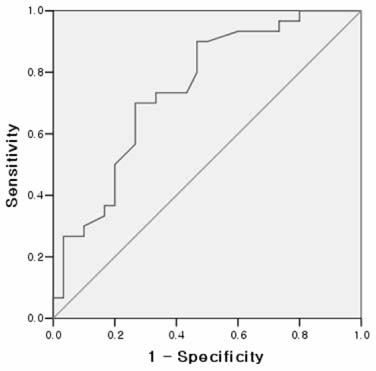J Korean Fract Soc.
2009 Jan;22(1):1-5. 10.12671/jkfs.2009.22.1.1.
The Usefulness of Hip to Thigh Ratio as an Anthropometric Indicator for the Incidence of Hip Fracture
- Affiliations
-
- 1Department of Orthopaedic Surgery, Ajou University School of Medicine, Suwon, Korea.
- 2Department of Orthopaedic Surgery, Yonsei University College of Medicine, Seoul, Korea. shmoon@yuhs.ac
- KMID: 2183880
- DOI: http://doi.org/10.12671/jkfs.2009.22.1.1
Abstract
- PURPOSE
To compare anthropometric indicators around the hip between osteoporotic fracture group and control group.
MATERIALS AND METHODS
Thirty patients for osteoporotic hip fracture and the same number of patients for spine fracture who admitted our institute from November 2006 to March 2007 were matched with control patients without osteoporotic fracture. The waist circumference (WC), hip circumference (HC), thigh circumference (TC), and height were measured. From these measurements, waist to hip ratio (WHR), waist to thigh ratio (WTR), hip to thigh ratio (HTR), waist to height ratio (WHtR), hip to height ratio (HHtR), and thigh to height ratio (THtR) were calculated. All these indicators were compared between hip fracture and control group, and between spine fracture and control group.
RESULTS
Comparison between spine fracture and control group showed that the WC, WHR, WHtR were statistically significant, but all indicators failed to show accuracy in the ROC analysis. Comparison between hip fracture and control group demonstrated the TC, WTR, HTR, WHtR, HHtR, THtR were statistically significant. However, only the HTR showed fair accuracy in the ROC analysis. The area under the curve (AUC) of the HTR was 0.75 (95% confidence interval, 0.62 to 0.87) (p=0.001).
CONCLUSION
The HTR was fairly accurate in predicting the incidence of hip fracture compared with any other anthropometric indicators. Therefore, we can consider that the HTR has clinical usefulness.
MeSH Terms
Figure
Reference
-
1. Chuang YC, Hsu KH, Hwang CJ, Hu PM, Lin TM, Chiou WK. Waist-to-thigh ratio can also be a better indicator associated with type 2 diabetes than traditional anthropometrical measurements in Taiwan population. Ann Epidemiol. 2006; 16:321–331.
Article2. Cooper C. The crippling consequences of fractures and their impact on quality of life. Am J Med. 1997; 103:12S–17S. discussion 7S-9S.
Article3. Craig P, Samaras K, Freund J, Culton N, Halavatau V, Campbell L. BMI inaccurately reflects total body and abdominal fat in Tongans. Acta Diabetol. 2003; 40:Suppl 1. S282–S285.
Article4. Cummings SR, Nevitt MC. A hypothesis: the causes of hip fractures. J Gerontol. 1989; 44:M107–M111.
Article5. Cummings SR, Rubin SM, Black D. The future of hip fractures in the United States. Numbers, costs, and potential effects of postmenopausal estrogen. Clin Orthop Relat Res. 1990; 252:163–166.6. Esmaillzadeh A, Mirmiran P, Azizi F. Waist-to-hip ratio is a better screening measure for cardiovascular risk factors than other anthropometric indicators in Tehranian adult men. Int J Obes Relat Metab Disord. 2004; 28:1325–1332.
Article7. Faulkner KG. The tale of the T-score: review and perspective. Osteoporos Int. 2005; 16:347–352.
Article8. Forsén L, Søgaard AJ, Sandvig S, Schuller A, Røed U, Arstad C. Risk of hip fracture in protected and unprotected falls in nursing homes in Norway. Inj Prev. 2004; 10:16–20.
Article9. Gallagher B, Corbett E, Freeman L, et al. A fall prevention program for the home environment. Home Care Provid. 2001; 6:157–163.
Article10. Hayes WC, Myers ER, Morris JN, Gerhart TN, Yett HS, Lipsitz LA. Impact near the hip dominates fracture risk in elderly nursing home residents who fall. Calcif Tissue Int. 1993; 52:192–198.
Article11. Kannus P, Parkkari J, Niemi S, et al. Prevention of hip fracture in elderly people with use of a hip protector. N Engl J Med. 2000; 343:1506–1513.
Article12. Kim JO, Yoen YH, Ko YD, et al. The prefracture factors on the hip fracture in elderly. J Korean Soc Fract. 2002; 15:531–537.
Article13. Koval KJ, Aharonoff GB, Rokito AS, Lyon T, Zuckerman JD. Patients with femoral neck and intertrochanteric fractures. Are they the same? Clin Orthop Relat Res. 1996; 166–172.14. Lauritzen JB, Petersen MM, Lund B. Effect of external hip protectors on hip fractures. Lancet. 1993; 341:11–13.
Article15. Mautalen CA, Vega EM, Einhorn TA. Are the etiologies of cervical and trochanteric hip fractures different? Bone. 1996; 18:3 Suppl. 133S–137S.
Article16. Moon SH, Suh BH, Kim DJ, Kong GM, Cho HG. Comparison of bone mineral density in elderly patients according to presence of intertrochanteric fracture. J Korean Fract Soc. 2007; 20:222–226.
Article17. Rico H, Relea P, Crespo R, et al. Biochemical markers of nutrition in type-I and type-II osteoporosis. J Bone Joint Surg Br. 1995; 77:148–151.
Article18. Rubenstein L. Hip protectors-a breakthrough in fracture prevention. N Engl J Med. 2000; 343:1562–1563.
Article19. Schneider HJ, Glaesmer H, Klotsche J, et al. Accuracy of anthropometric indicators of obesity to predict cardiovascular risk. J Clin Endocrinol Metab. 2007; 92:589–594.
Article
- Full Text Links
- Actions
-
Cited
- CITED
-
- Close
- Share
- Similar articles
-
- Intertrochanteric fracture associated with posterior hip dislocation
- Second hip fracture in Hong Kong e Incidence, demographics, and mortality
- Total hip arthroplasty in unreduced fracture dislocation of the hip
- The incidence of hip fracture and mortality rate after hip fracture in Korea: A nationwide population-based cohort study
- Incidence, Morbidity and Mortality in Patients Older than 50 Years with Second Hip Fracture in a Jeju Cohort Study


